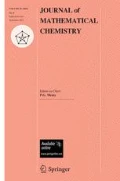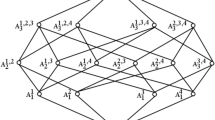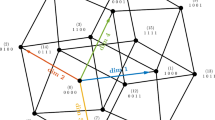Abstract
The concept of Fuzzy Hypercube is defined as a simple trigonometric extension of the binary structure of an N-dimensional Boolean hypercube. Moreover, in the present study, there is a discussion on the possibility of defining Fuzzy Hypercubes as a set of \( 2^{N} \) vertices, which remain Stationary or might undergo Synchronous or Asynchronous evolution. Finally, the connection of Fuzzy Hypercubes with multivariate discrete probability distributions is also considered.
Similar content being viewed by others
Notes
Such a time-dependent probability choice looks like a not so common situation. In a bivariate case would appear as if a coin toss probability could evolve with each observation, which is not a usual studied phenomenon. However, it appears very similar to the possible evolution of a quantum spin system.
References
K. Balasubramanian, J. Math. Chem. 56, 2707–2723 (2018)
K. Balasubramanian, J. Math. Chem. 57, 665–689 (2019)
R. Carbó-Dorca, J. Math. Chem. 22, 143–147 (1997)
R. Carbó, B. Calabuig, Molecular similarity and quantum chemistry, in Concepts and Applications of Molecular Similarity, ed. by M.A. Johnson, G.M. Maggiora (Wiley, New York, 1990), pp. 147–171
R. Carbó, B. Calabuig, Intl. J. Quant. Chem. 42, 1695–1709 (1992)
R. Carbó-Dorca, J. Math. Chem. 54, 1213–1220 (2016)
R. Carbó-Dorca, J. Math. Chem. 55, 914–940 (2017)
R. Carbó-Dorca, J. Math. Chem. 56, 1349–1352 (2018)
R. Carbó-Dorca, J. Math. Chem. 56, 1353–1356 (2018)
R. Carbó-Dorca, J. Math. Sci. Model. (JMSM) 1, 1–14 (2018)
R. Carbó-Dorca, J. Math. Chem. 57, 694–696 (2019)
R. Carbó-Dorca, J. Math. Chem. 57, 697–700 (2019)
R. Carbó-Dorca, T. Chakraborty, J. Comput. Chem. 40, 2653 (2019)
R. Carbó-Dorca, T. Chakraborty, J. Math. Chem. 57, 2182–2194 (2019)
R. Carbó-Dorca, J. Math. Chem. 58, 1–5 (2020)
L. Cardelli, M. Kwiatkowska, M. Whitby, Nat. Comput. 17, 109–130 (2018)
J. Olejarz, K. Kaveh, C. Veller, M.A. Novak, J. Theor. Biol. 457, 170–179 (2018)
R. Carbó-Dorca, J. Math. Chem. 30, 227–245 (2001)
R. Carbó-Dorca, J. Math. Chem. 36, 75–81 (2004)
R. Carbó-Dorca, J. Math. Chem. 54, 1751–1757 (2016)
R. Carbó-Dorca, C. Muñoz-Caro, A. Niño, S. Reyes, J. Math. Chem. 55, 1869–1877 (2017)
S. Kais (ed.), Quantum Information and Computation for Chemistry (Advances in Chemical Physics, vol. 54), S.A. Rice, A.R. Dinner (Series Editors) (2014)
F. Arute, K. Arya, R. Babbush, D. Bacon, J.C. Bardin, R. Barends, R. Biswas, S. Boixo, F.G.S.L. Brandao, D.A. Buell, B. Burkett, Y. Chen, Z. Chen, B. Chiaro, R. Collins, W. Courtney, A. Dunsworth, E. Farhi, B. Foxen, A. Fowler, C. Gidney, M. Giustina, R. Graff, K. Guerin, S. Habegger, M.P. Harrigan, M.J. Hartmann, A. Ho, M. Hoffmann, T. Huang, T.S. Humble, S.V. Isakov, E. Jeffrey, Z. Jiang, D. Kafri, K. Kechedzhi, J. Kelly, P.V. Klimov, S. Knysh, A. Korotkov, F. Kostritsa, D. Landhuis, M. Lindmark, E. Lucero, D. Lyakh, S. Mandrà, J.R. McClean, M. McEwen, A. Megrant, X. Mi, K. Michielsen, M. Mohseni, J. Mutus, O. Naaman, M. Neeley, Ch. Neill, M.Y. Niu, E. Ostby, A. Petukhov, J.C. Platt, Ch. Quintana, E.G. Rieffel, P. Roushan, N.C. Rubin, D. Sank, K.J. Satzinger, V. Smelyanskiy, K.J. Sung, M.D. Trevithick, A. Vainsencher, B. Villalonga, T. White, Z.J. Yao, P. Yeh, A. Zalcman, H. Neven, J.M. Martinis, Nature 574, 505–511 (2019)
E. Pednault, J. A. Gunnels, G. Nannicini, L. Horesh, R. Wisnieff. arxiv preprint, arXiv:1910.09534 v2 (2019)
Author information
Authors and Affiliations
Corresponding author
Ethics declarations
Conflict of interest
The authors state that there is no conflict of interest related to this work.
Additional information
Publisher's Note
Springer Nature remains neutral with regard to jurisdictional claims in published maps and institutional affiliations.
Rights and permissions
About this article
Cite this article
Chang, J., Carbó-Dorca, R. Fuzzy Hypercubes and their time-like evolution. J Math Chem 58, 1337–1344 (2020). https://doi.org/10.1007/s10910-020-01137-y
Received:
Accepted:
Published:
Issue Date:
DOI: https://doi.org/10.1007/s10910-020-01137-y




